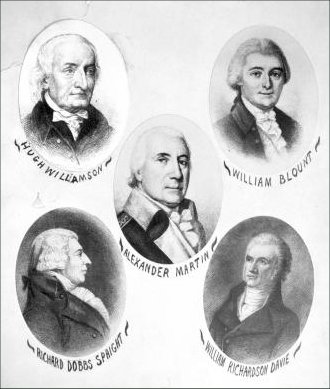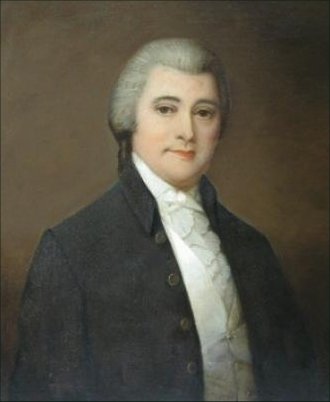Publisher's note: We believe the subject of history makes people (i.e., American people) smarter, so in our quest to educate others, we will provide excerpts from the North Carolina History Project, an online publication of the John Locke Foundation. This one hundred and twenty-second installment, by Michael Toomey of East Tennessee Historical Society is provided courtesy of the North Carolina History Project, and re-posted here with permission from NC Historic Sites.
William Blount is pictured in the top right corner of this composite, along with other prominent Federalists from North Carolina. Image courtesy of the North Carolina Office of Archives and History, Raleigh, NC.
William Blount, the eldest son of Jacob Blount, Sr., and Barbara Gray Blount, was born in Bertie County, North Carolina, on March 26, 1749. He was active in the family mercantile business and later served in the American Revolution as paymaster of the 3rd North Carolina regiment and for the state militia. Blount left the military before the war's end to pursue two passions that would obsess him for the rest of his life. The first was western lands; like many businessmen of his day, Blount believed the future of the new nation lay beyond the Appalachian Mountains so he accumulated as much western land as possible. The other obsession was public office. As early as 1780 he served in the state legislature. He later represented North Carolina in the Continental Congress. In 1787 he was appointed as a delegate to the Constitutional Convention. There is little indication that Blount actively participated in the debates at the convention, but he did attend the sessions and signed the new U.S. Constitution.
William Blount (above) was born in Bertie County, NC. He later represented North Carolina at the Continental Convention (1787-1788). Image courtesy of the Tennessee State Museum, Tennessee Historical Society Collection, Nashville, TN.
It was apparently during the Constitutional Convention that Blount came to the attention of George Washington, a contact that served him well when North Carolina ceded its western lands to the federal government. Commonly called the Southwest Territory, the North Carolina land comprised all of present-day Tennessee and stretched from the crest of the Appalachian Mountains to the Mississippi River. The most important office in the new territorial government was that of governor, and for this position Washington selected William Blount.
From Blount's perspective it was an ideal assignment. By this time he had acquired a million acres of western land, and it is likely that through partnerships he controlled much more. In fact Blount had already determined that he must move west in order to protect his vast holdings; his appointment as governor would only make that task easier.
Blount arrived in the territory in October 1790. His appointment carried with it the position of Superintendent of Indian Affairs, and he was specifically charged by his immediate superior, Secretary of War Henry Knox, to resolve the ongoing dispute regarding the Cherokee boundary. In June 1791, Blount called the Cherokee to a treaty at White's Fort on the Holston River, in present-day Knoxville. The Treaty of the Holston, signed in early July, called for additional Cherokee land cessions and set a new boundary, thereby resolving the conflict. However, frustrated Cherokee believed Blount had treated them unfairly.
Despite this awkward beginning, Blount maintained good relations with the Cherokee, although a militant faction continued to attack the territory for several years. Likewise he was generally able to prevent white settlers from encroaching across the Cherokee boundary. But attacks by the militant Cherokee and the Creek continued, and each attack led to renewed calls for a federal army to be stationed in the territory for protection. Blount increasingly found himself caught between his superiors, who refused to consider such a demand, and the citizens who were very clearly in need of protection.
For Blount, the only way out of this impasse was to move as quickly as possible toward statehood. When a 1795 census revealed a population in excess of 60,000, large enough to satisfy the provisions in the Northwest Ordinance, Blount dispatched a delegate to Congress with instructions to lobby for immediate admission. The delegate soon discovered that the Federalist-controlled Congress was certain that angry westerners would vote against the Federalist candidate in the upcoming presidential election. Therefore, Congress did not take any steps to admit Tennessee to statehood.
To get around this obstacle, Blount decided to proceed without the blessing of Congress and, since Tennessee was the first territory to seek admission under the provisions of the Northwest Ordinance, there were no precedents to restrict him. Blount first called for a constitutional convention and, once convened, he pushed the delegates to move quickly and draft a state constitution. When the new document was approved, Blount simply declared that his territorial government was terminated and the new Tennessee state constitution was operational. The Federalists were unable to prevent a joint session of Congress from approving the new constitution or the process by which it had been submitted. On June 1, 1796, Tennessee was admitted to statehood.
Blount was no longer governor, but he had secured an appointment as Senator from Tennessee. From this vantage point he hatched a plan to manipulate land prices in the west, for Blount had accumulated far too many acres and the market for western lands had not developed as he anticipated. He was convinced, however, that land values would rise if the British controlled the port of New Orleans, and so he arranged for Creek and Cherokee Indians to assist the British in capturing the city from the Spanish. Blount's plot was discovered, and in August 1797, he was promptly expelled from the Senate.
Blount returned to Tennessee, where he remained popular. He was elected to the state senate and served in this capacity until September 1799. In March of the following year, William Blount complained of a chill and died after a six-day illness. He is buried at the First Presbyterian Church in Knoxville.
A land speculator and businessman from an influential family with political connections, William Blount seemingly had little in common with the people he governed. But while he operated on a much larger scale, his desire to improve his financial standing through the acquisition and sale of land was typical of the frontier. Likewise, his insistent requests for an increased federal military presence to confront the ongoing threat of Indian attacks only served to increase his popularity among the people he governed. To them, his administration was seen as responsive, effective, and fair. At the same time, Blount's superiors in the War Department came to view his administration with considerable suspicion as a result of rumors that he had misappropriated funds, but an informal investigation failed to produce any evidence. In the end this native North Carolinian, who signed the U.S. Constitution, is remembered as the driving force behind the Tennessee Constitution and statehood, and for his expulsion from the United States Senate.
Sources:
Thomas Perkins Abernethy, From Frontier to Plantation in Tennessee: A Study of
Frontier Democracy (Chapel Hill, 1932); John D. Barnhart, Valley of Democracy: The Frontier vs. the Plantation in the Ohio Valley (Bloomington, 1953); Clarence E. Carter, ed., The Territorial Papers of the United States: The Southwest Territory, vol. 4, Washington, 1936; Walter T. Durham, "The Southwest Territory: Progression to Statehood," The Journal of East Tennessee History (1990) 62: 3-17; William B. Eigelsback, "The Blount Conspiracy: Notes of Samuel Sitgreaves on the Questioning of Dr. Nicholas Romayne on July 13 and 14, 1797, Before the House Impeachment Committee," 66 (1994), 81-96; John R. Finger, Tennessee Frontiers: Three Regions in Transition (Bloomington, IN, 2001); Philip M. Hamer, ed., "Letters of Governor William Blount," The East Tennessee Historical Society's Publications (1932) 4: 122-137; William H. Masterson, William Blount (Baton Rouge, 1954); William H. Masterson, "The Land Speculator and the West: The Role of William Blount," The East Tennessee Historical Society's Publications (1955) 27: 3-8; Buckner F. Melton Jr., The First Impeachment: The Constitution's Framers and the Case of Senator William Blount (Macon, GA, 1998); Michael Toomey, "'Doing Justice to Suitors': The County Courts in the Southwest Territory," The Journal of East Tennessee History (1990) 62: 33-53.



This is a good picture of Indian affairs and personal gain connected with a powerful appointee to government. As today, those with means seem to get the call.
It appears to me that the man was one of good will and pressure to please both Indians and settlers. Hard dilemma to do both and, as time tells us, impossible!